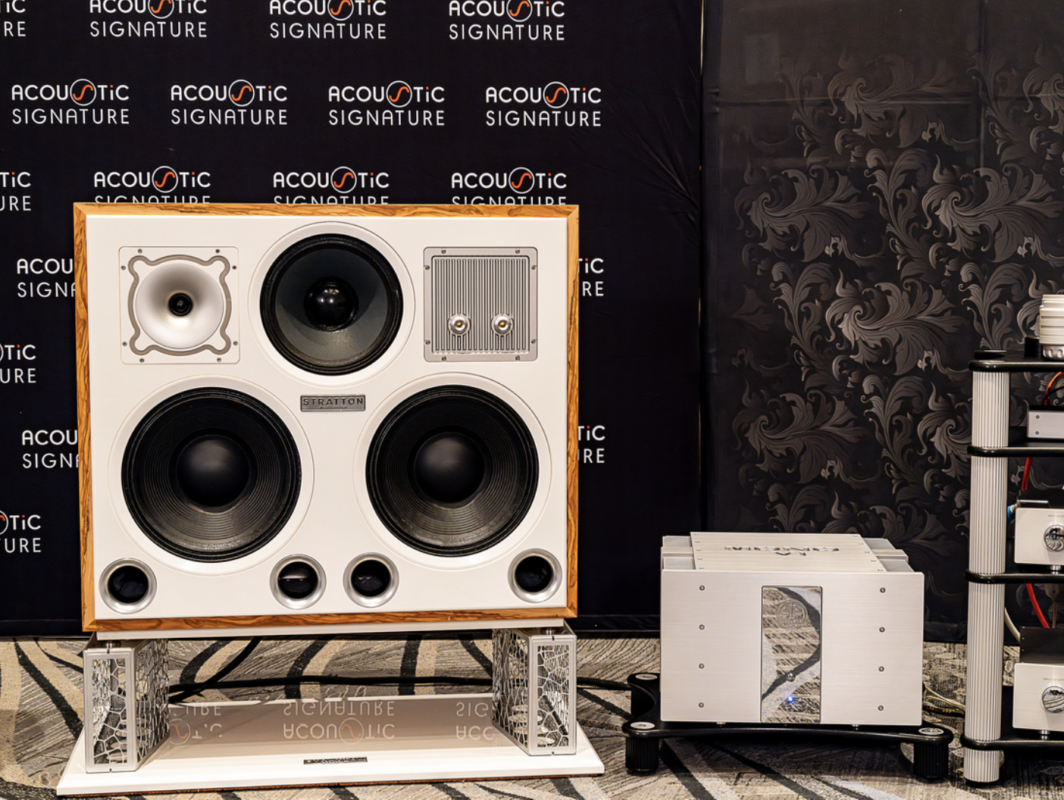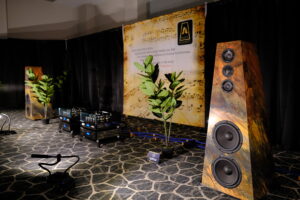
Click here to check out our entire list of RMAF 2011 blogs.
Before getting to my beat at this show—electronics above $15k—I’d like to tell you about what was for me show’s sonic and musical highlight. Acoustic Sounds teamed up with British loudspeaker manufacturer ATC to present the 5.1-channel remix of Pink Floyd’s Wish You Were Here on SACD. Acoustic Sounds, who is re-issuing the SACD, rented a conference room arrayed with five huge ATC monitors—the same monitors used to mix the record. Longtime Pink Floyd engineer James Guthrie was on hand to talk about his mix. They turned down the lights and played the entire album from start to finish. The small audience was transfixed by the experience. Although I’d heard this album quite a number of times over the years, listening to this new multichannel mix was like experiencing the record for the first time. Not only was the sound greatly improved, but the tasteful use of the center and surround channels served to convey the genius of this album. The SACD will be available by the time you read this.
Moving on to new electronics at the show, I saw, but didn’t hear, the new Hegel H30 monoblock power amplifiers (Hegel was demonstrating its entry-level gear). The Norwegian company is known primarily for its mid-priced integrated amplifiers and separates, not for ambitious monoblocks. But Hegel has some interesting and unique audio circuits, and decided to implement those circuits in a no-holds-barred product. The amplifier eliminates upper-order harmonic distortion (the most audible kind) by using a single pair of matched FETs per phase in both stages. Hegel tests more than 200 transistors to find one matched pair, meaning that 1600 transistors are tested to find the H30’s eight pairs. The H30, rated at 1100W into 8 ohms, will carry a retail price of $15,000 each. The matching P30 preamp, which uses similar circuitry along with the hand-matched transistors, is $7500. Hegel’s mid-priced integrated amplifiers are outstanding; it will be interesting to hear what it can do in a more ambitious implementation.
Another auspicious product debut came from Audio Research in the form of the Reference 250 monoblock amplifiers. This all-new, ground-up design of the amplifier that replaces the Reference 210 in the line features newly developed audio circuits, KT-120 output tubes, a 50% bigger power supply than its predecessor, quieter fans, and analog front-panel meters. ARC claims that the Reference 250 sounds better than even the company’s fabulous (and now discontinued) Reference 610T. The $25,990 (per pair) Reference 250 sounded absolutely magnificent driving Vandersteen 7 loudspeakers through AudioQuest interconnects and cables in the room of Colorado retailer The Audio Alternative. The system had a seamless coherence, liquidity of timbre, and superb resolution. This room was one of my two best sounds at the show.
VTL also announced and demonstrated a significant tube monoblock amplifier, the Siegfried Series II. An a major revision of the Siegfried platform, the new circuit is fully balanced, features a shorter feedback loop that is now balanced, uses no global feedback, and features an output stage with a lower output impedance. Parts upgrades include Mundorf silver-oil capacitors and extensive use of Teflon bypass caps. The price is $65,000 per pair.
Music Culture Technology, the firm founded by Wolfgang Meletzky, launched an ambitious new line that includes the mc 811 solid-state monoblock, a squarish-looking unit mounted on feet and finished in gloss black. The 811s will be available in November at a U.S. retail price of $15,990 per pair. The 300W unit includes a front-panel switch that allows the user to tailor the amplifier’s output stage to the loudspeaker’s impedance, specifically whether the loudspeaker likes to be driven by voltage or by current.
Another company making handcrafted amplifiers, Doshi Audio, created some great sound driving Wilson Sasha loudspeakers with its Alaap V2.1 full-function preamp ($14,995) and Jhor monoblocks ($18,995 per pair). Although the circuits are based on classic designs from the 1950s, the implementation is state-of-the-art. For example, the preamplifier’s volume control is a 31-position transformer rather than a potentiometer or a switched-resistor network. The phono section is fully balanced, features a four parallel triode section, and a passive RIAA network. The 90W Jhor power amplifier employs two pairs of EL34s, again in a classic circuit with a massive supply and the best associated parts. The rest of the system included the SME 20/3 turntable/Series V arm fitted with a Koetsu Onyx Platinum cartridge, a Wadia S7i CD player, Transparent Audio cables and power conditioning throughout, and racks from Harmonic Resolution Systems.
Concert Fidelity launched a new tube hybrid linestage, the CF-080 LSX2. The $20,000 unit features a unique volume control that has no physical contacts in the signal path. Gain is provided by a pair of 12AU7 tubes that stick out of the rear panel, and a 6CA4 tube functions as a rectifier. The system I heard with the Concert Fidelity ZL-200 monoblocks ($40k per pair) and DAC-040 tube hybrid D/A converter driving the Kawero! loudspeaker from Kaiser Acoustics through Fono Acustica cables did a disappearing act, leaving an engaging musicality in place of the hardware. Concert Fidelity is a 24-year-old artisanal Japanese company that strives for minimalist circuits. All the products are hand-made by the founder and designer, Masataka Tsuda.
BSG Technologies got people talking about its QOL “Signal Completion Stage” processor that I previewed in prototype form two years ago. This $3995 unit is pure analog from input to output (it can fit between your preamp and power amp, or between a source and your preamp) and reportedly restores information buried in the signal. The front-panel bypass button allows you to instantly hear the unit’s effect. I’ve been listening to a review sample at home for two weeks, and was glad for the opportunity to hear it under other conditions. Everyone who heard the demo at RMAF was wowed by the increase in spaciousness and clarity, which is consistent with my listening at home. Watch for a full review.
I’ll tell you about a new cable company called Clarus. New cables companies are a dime-a-dozen, but Clarus combines more than 20 years of cable-manufacturing know-how with the design talents of noted cable designer Jay Victor. Created by cable giant Tributaries, the Clarus Audiophile Collection is an attempt to bring high performance to sensibly priced cables. The line includes two models each of interconnects (balanced and unbalanced), loudspeaker cables, digital cables, and power cords. The cables feature Pure Copper Ohno Continuous Casting copper, individually insulated strands, and CNC-machined gold-plated connectors. Prices range from $500 for a meter pair of unbalanced interconnects to $2600 for the top loudspeaker cable.
I’ll close with a funny story. While listening to a system of Vandersteen 7s, Aesthetix amplification, and Clearaudio’s new $32,000 Master Innovation turntable with stand, I overheard this conversation between a couple: Woman: “Are you going to buy that turntable?” Man: “Maybe. I don’t know yet.” Woman: “I think we should get that one. It looks so sexy.” Ah, we should all be so lucky.
Robert Harley’s Best of Show
Best Sound (cost no object)
Vandersteen 7s with ARC Reference 250 amplifiers and AudioQuest cables; Magico Q1s driven by BALabo electronics.
Best Sound (for the money)
The $2550-per-pair Studio Electric Monitors (reviewed last issue) not only sounded wonderful, but have a tremendous retro-cool vibe.
Greatest Bargain
The $3000 FET Valve 400R power amplifier from Audio by Van Alstine. With a tube input stage, regulated supplies to the output MOSFETs, and 200Wpc on tap, the 400R could be a giant killer. It sounded great driving Salk Song Tower speakers.
Most Significant Product Introduction
BSG Technologies QOL Signal Completion Stage. I’m still coming to grips with this potentially groundbreaking technology, but early indications are promising.
Most Significant Trend
The emergence of the dual-source demo at shows: music servers and turntables. The ascension of high-res, convenience of music servers, and the growing resurgence of vinyl are putting the final nails in the CD’s coffin, at least at shows.

By Robert Harley
My older brother Stephen introduced me to music when I was about 12 years old. Stephen was a prodigious musical talent (he went on to get a degree in Composition) who generously shared his records and passion for music with his little brother.
More articles from this editorRead Next From Show
See all
We Bring you Full Coverage of the 2024 AXPONA Show
- Apr 18, 2024

Best of Show: Southwest Audio Fest 2024
- Mar 18, 2024




















